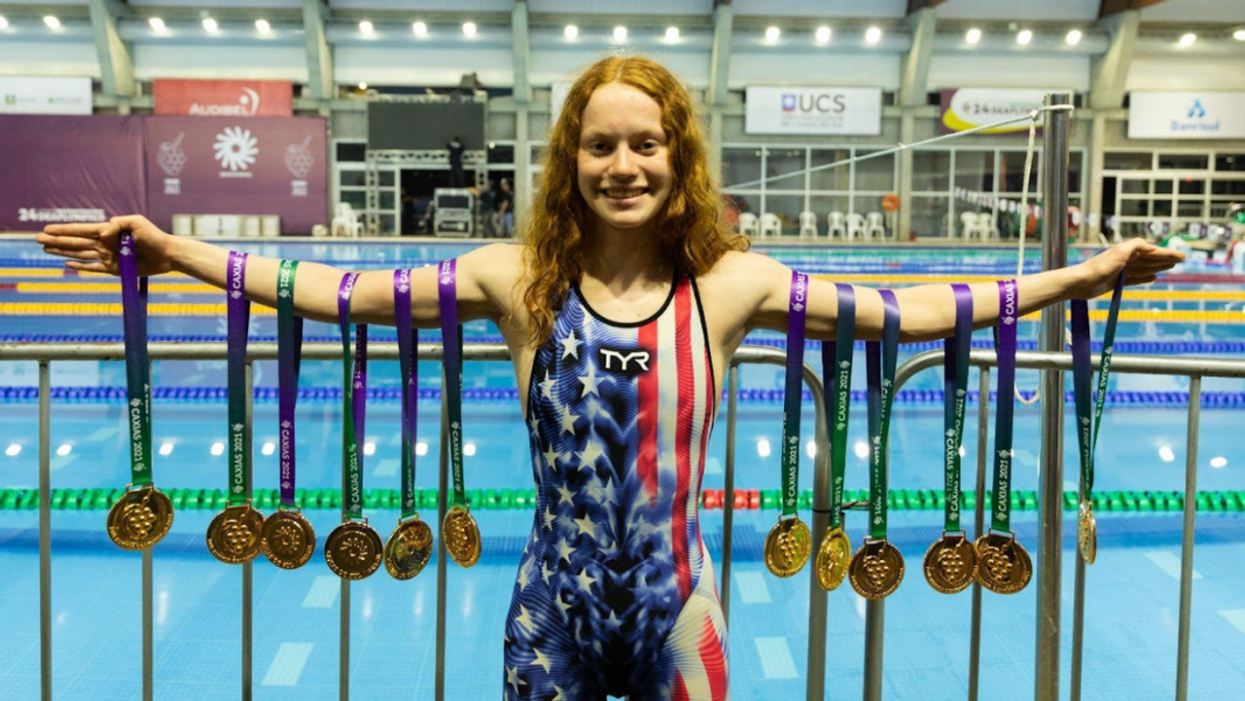Howard Gorrell attended 13 of the last 14 Deaflympics since 1969 and is a 2004 recipient of the USADSF Jerald M. Jordan Award, given to those who exhibit leadership and continuous participation toward the goals of the Deaflympics.
As National Disability Awareness Month started on March 1st, USA athletes participating in the past Deaflympics have demanded the United States Olympic and Paralympic Committee (USOPC) be aware of the needs of the USA Deaflympians in the past four decades.
Under the USOPC Enhanced Operation Gold program, Carli Cronk (pictured) could collect $6,250 for one gold medal (if the Texas University Interscholastic League would allow it). Identical to her USA teammate, Matthew Klotz of Cameron Park, CA. who set a new Deaflympic record for most medals ever by an athlete in a single Deaflympic Games, with 14 shiny pieces of metal (five golds, two silvers, and seven bronzes.) Whoa! Unfortunately, both swimmers received zero from the USOPC via their federation, USA Deaf Sports Federation (USADSF.) Why?
Cronk might lose one or two golds if a one-time Deaflympian and three-time Paralympian named Becca Meyers of Timonium, MD, would enter the Brazilian Games. Two years ago, Meyers made national news by withdrawing from the 2021 Tokyo Paralympics after the USOPC denied her accommodation request to bring her personal care assistant. Then the two-time winner of the ESPYs Best Female Athlete with a Disability Award decided not to rejoin the 2022 USA Deaf Swimming team. Why?
Next to Rihanna during the Super Bowl halftime show, a hard-of-hearing young woman named Justina Miles of Philadelphia wooed the stadium audience and streaming television viewers with her ultra-beautiful American Sign Language performance interpreting Rihanna's singing. Despite having hundreds of thousands of followers watching her performances on TikTok and Instagram, Miles was a little disappointed that a few media told readers/viewers that she received a silver medal in the women's 4×100 relay in her first appearance in the 2022 Deaflympics. Why so few?
On a cold November day in 1976, a deaf congressional staffer walked across the Senate Park to one building next to Union Station and unexpectedly entered the temporary office of the President's Commission on Olympic Sports (PCOS.) Olympian runner Ken Moore greeted him and asked what the latter wanted. The deaf man explained about the World Games for the Deaf ( renamed to Deaflympics in 2001). Suddenly, PCOS Executive Director Michael Harrigan rang the White House and requested a delay of the deadline for submitting a final report because Harrigan wanted to include the problem of athletes who are handicapped in the PCOS Final Report. [Note: the term "handicapped" was common at that time, and we are using "disabled" now.] Why did the deaf man go there?
That man is me. Joining me, Carli Cronk, Matthew Klotz, Becca Meyers, and Justina Miles are proud of being Deaflympians. Still, we have to work hard with the USOPC to consider the inclusion of Deaflympics into their program.
No inclusion means that Cronk and Klotz could not get the prize money from the USOPC; that Meyers could not get free expenses to Deaflympics, although she had free rides to Paralympics; and that Miles could not receive publicity from the USOPC because the latter has yet recognized the word, Deaflympics, although the National Football League press releases had a resourceful paragraph about her getting a silver medal.
Last month the Commission on the State of the U.S. Olympic and Paralympics (CSUSOP), formed by the Empowering Olympic, Paralympic, and Amateur Athletes Act of 2020, is finally underway after a two-year wait for obtaining a federal fund.
One area where the USOPC should prevent future governance failures within the U.S. Olympic movement is by imposing greater legal liability on themselves for harmful acts. The federal legislators referred to the gymnastic scandal. Still, I have pointed out that the USOPC has continued to ignore the plea from Deaflympians.
Leading the 16-member commission, Co-chair Han Xiao, former USOPC Athletes' Advisory Council chair, might be surprised after discovering that the Deaflympics is the second oldest Olympic-type competition in the world, next only to the Olympics. It was first held in Paris in 1924 as the International Silent Games for the Deaf --- just two weeks after the end of the 1924 Summer Olympics, also in Paris.
Co-Chair Dionne Koller, a University of Baltimore law professor who authored “ A Twenty-First-Century Olympic and Amateur Sports Act,” might learn that the $96 million U.S. Olympic and Paralympic Museum has no exhibit about the President's Commission on Olympic Sports. Harrigan exclaimed that "the PCOS and the Amateur Sports Act of 1978 are the most important things ever to have happened to the U.S. Olympic Committee in its entire history, in terms of positive effects on things, and I think the museum should reflect that."
Member Mitch Daniels (President, Purdue University) might be interested to read “ The World Games for the Deaf and the Paralympic Games.” Then he would learn that the International Olympic Committee recognized the International Committee of Sports for the Deaf (ICSD) in 1955 (68 years ago-!)
Member Benita Fitzgerald Mosley (track & field) might feel sorry for our forgotten Deaflympians after reading Deaflympian Runner Emily Wilson’s explanation on why deaf representation on the USA team is so low.
Member Bill Hybl (President Emeritus of USOPC) might feel shamed after reading the 2003 House Hearing document quoting, “Dr. Harvey W. Schiller, former USOC Executive Director: ‘And my comment was really made to say that each and every organization ranging from those that represent disabled organizations to the deaf, to Special Olympics, to seniors; there are things called the Transplant Games, to the Gay Games, to others all make requests of funds to support their organizations’.”
Member Nancy Hogshead-Makar (swimming) might applaud Cronk and Klotz for receiving from the ICSD the 2022 Sportswoman of the Year Award and the 2018 Sportsman of the Year Award, respectively.
The other members, John Dane (sailing), Brittney Reese (track and field), Jordyn Wieber (gymnastics), Patty Cisneros Prevo (basketball), Karin Korb (tennis), Melissa Stockwell (triathlon), Robert Cohen (USOPC Foundation Board of Directors), Rob Mullens (University of Oregon Athletic Director), and Joe Schmitz (former Inspector General at the U.S. Department of Defense) might flip tens of documents submitted by USADSF President Jeffrey Mansfield to see any more wrongdoings by the USOPC.
The USOPC website states, “USOPC Diversity, Equity & Inclusion is: Many Faces, One Team, One Mission.” They must forget to add, “Except for Deaf Athletes.”
On March 29, 1978, Col. F. Don Miller, then USOC Executive Director, wrote to the Secretary-Treasurer of the American Athletic Association of the Deaf (now USADSF), “If the Amateur Sports Act of 1978, S. 2727, is enacted, and a coordinated program of amateur sports is provided for the handicapped, and coordinated by the USOC, I would be prepared to recommend the use of Olympic terminology is association with your activities.”
This act was enacted 45 years ago, but the current USOPC has still ducked the legendary USOPC figure’s recommendation.
Member Edwin Moses, my friend who graduated from my Dayton [OH] Fairview High School with a 300-yard track, quoted, “In the digital world, sport provides an opportunity to bring people together.”
My simple reason for going to the PCOS office was to tell them that parity with the USOPC should motivate future athletes who are deaf, deaf-blind, and hard of hearing. If the USOPC agrees to include the Deaflympic program, it will end my 45-year battle for parity with the USOPC.



















